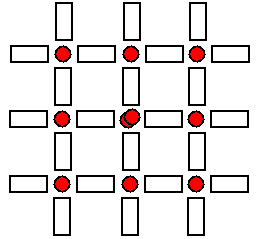Klondike
A domino game by Arne Matschinsky . It has no connection with the Solitaire card game of the same name.
Equipment
The game uses a double six domino set and Poker chips in one color. You can play with 2, 3 or 4 players.
 The Deal
The Deal
Put 9 chips in a grid pattern (3x3). Leave enough space between the chips for one tile placed lengthways. Put a second chip on top of the chip in the centre position. Tiles will be placed around and between the chips as shown in the diagram.
The tiles are distributed equally to the players.
- 2 players - 14 tiles each
- 3 players - 7 tiles each (the remaining 7 tiles are kept face down in reserve)
- 4 players - 7 tiles each
The Play
For the first deal, choose a player to start the game. After each subsequent deal the turn to start passes to the next player to the left. Play is clockwise.
At every turn, the player has to place one tile if possible. Tiles are placed in any empty space with one or both short sides next to a chip, as shown in the diagram.
If there are tiles in the reserve, then after playing, the player replenishes his or her hand by drawing a tile from the reserve. When the reserve is empty, play continues without replenishment until the layout is full.
If a chip already has a tile next to it, the chip is assigned the number on the end of the tile that is next to it. Not more than two chips can be assigned the same number. (So for example if the [4-4] is placed between two chips, no tile can be placed with a 4-end next to any other chip.)
If a tile is placed next to a chip that already has a number, then the end of the newly placed tile that is next to that chip must also have the same number, if possible.
A player who places the fourth and last tile next to a chip position in such a way that the four numbers next to the chip position are all the same, wins all the chips in that position.
Note. It is possible for a player to win chips from two positions in a single play.
Sometimes it is impossible for an interior position in the layout to be filled, matching the numbers at both ends of the tile, because the required tile has already been played elsewhere on the layout. In this case, it is legal to play a tile in this position where just one end matches. If even this is not possible - because the tiles that could match either end have already been played elsewhere, then any tile can be played in that position.
If there is an empty exterior position in the layout where no tile can be played that matches the number assigned to the adjacent chip, then any tile can be played in that position.
A player who is unable to play a tile (because the only tiles that can legally be played in the remaining spaces are in the hands of the other players) must pass.
Scoring
When tiles have been placed in all 24 spaces, all the tiles are gathered up and shuffled and there is a new deal. One new chip is added to each of the nine chip positions. In this way piles of chips can build up in positions where the chips were not won in previous deals.
Twice as many deals are played as the number of players taking part - so that each player has two opportunities to start. Any chips remaining in the grid belong to no one. All players count the how many chips they have won and the player with most chips is the winner.
Comments and Variations
In the two-player game the players begin with complete information, so it has a chess-like feel. Players who prefer to allow some element of chance can instead deal (for example) 9 tiles to each player, leaving a reserve of 10 tiles from which a tile is drawn after each turn until it is empty.
Arne Matschinsky would like to hear from anyone who tries this game and has comments or suggestions for improvement. Here are his rules of Klondike in German.